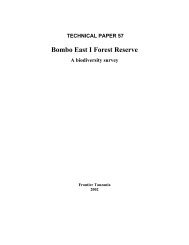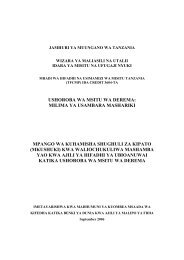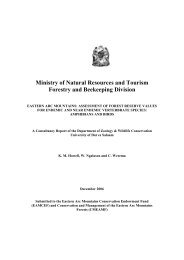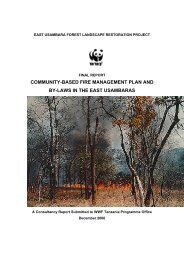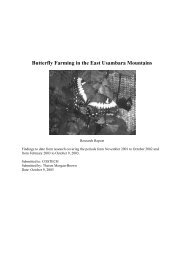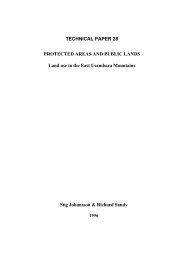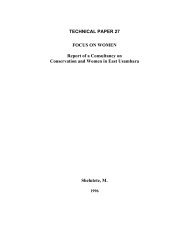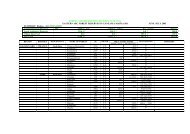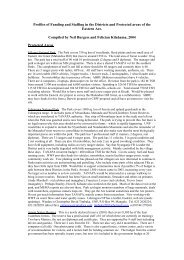Mgambo Forest Reserve: A biodiversity survey. - Eastern Arc ...
Mgambo Forest Reserve: A biodiversity survey. - Eastern Arc ...
Mgambo Forest Reserve: A biodiversity survey. - Eastern Arc ...
You also want an ePaper? Increase the reach of your titles
YUMPU automatically turns print PDFs into web optimized ePapers that Google loves.
<strong>Mgambo</strong> <strong>Forest</strong> <strong>Reserve</strong><br />
4.4 Discussion<br />
<strong>Mgambo</strong> FR covers an area of 13.46 km 2 (1346 ha) with an altitude range of 300m to 800m above<br />
sea level. Topography is, at times, fairly steep but not extreme and the landscape generally a mix<br />
of open woodland, scrub and grassland. <strong>Mgambo</strong> FR only containted small patches of lowland<br />
forest and riverine forest habitat.<br />
Habitat<br />
Of the 31 vegetation plots <strong>survey</strong>ed systematically, 20 were open woodland (65% of plots), 5<br />
were lowland forest (16% of plots) and 6 were scrub/grassland/previously disturbed (19% of<br />
plots). <strong>Mgambo</strong> FR had previously been recorded as 96% poorly stocked lowland forest by<br />
Johannson and Sandy (1996). The large proportion of open woodland actually recorded suggests<br />
increased disturbance in recent years. None of the vegetation plots was recorded with an average<br />
canopy height of over 20m. Approximately two-thirds of vegetation plots had been affected by<br />
fire.<br />
Species richness<br />
In the systematic vegetation plots 858 trees and shrubs were <strong>survey</strong>ed, representing 101 species<br />
from 31 families. An additional five species were recorded in the regeneration plots. Opportunistic<br />
observations and collections recorded an additional 22 plant species from 14 families. In total 128<br />
plant species from 39 families were recorded.<br />
Relative to other forest reserves <strong>survey</strong>ed in the East Usambara Mountains the botanical diversity<br />
of <strong>Mgambo</strong> FR was low, largely as a result of the high level of fire and grazing disturbance.<br />
The most abundant species in vegetation plots, representing 9.0% of individuals was the woodland<br />
species Combretum zeyheri. Other commonly encountered species in vegetation plots were<br />
Dombeya shupangae, Brachystegia spiciformis, Acacia nilotica, Grewia bicolor, Cordia ovalis<br />
and Maytenus undata . All of these species were seen to be resilient to disturbance and at<br />
competetive advantage in disturbed areas.<br />
Endemic Status<br />
The majority of species recorded in vegetation plots (87%) had widespread distributions. Only the<br />
species Cassia abbreviata was recorded as endemic to the Usambara Mountains and 12 species<br />
were recorded as near endemic. The most commonly recorded near-endemic tree species in the<br />
reserve was Dombeya shupangae (55 individuals), then was Scorodophloeus fischeri (15<br />
individuals) and Canthium mombazense (10 individuals). Endemic and near endemic species were<br />
fairly evenly distributed in the reserve, but tended to be more frequently found in the western half<br />
of the reserve.<br />
Only two near endemic species recorded in vegetation plots were forest dependent, namely<br />
Deinbollia kilimandscharica and Zanthoxylum deremense. Three near endemic species, Dombeya<br />
shupangae, Scorodophloeus ficheri and Monodora grandidieri are non-forest species.<br />
East Usambara Conservation Area Management Programme Technical Paper 59<br />
40



